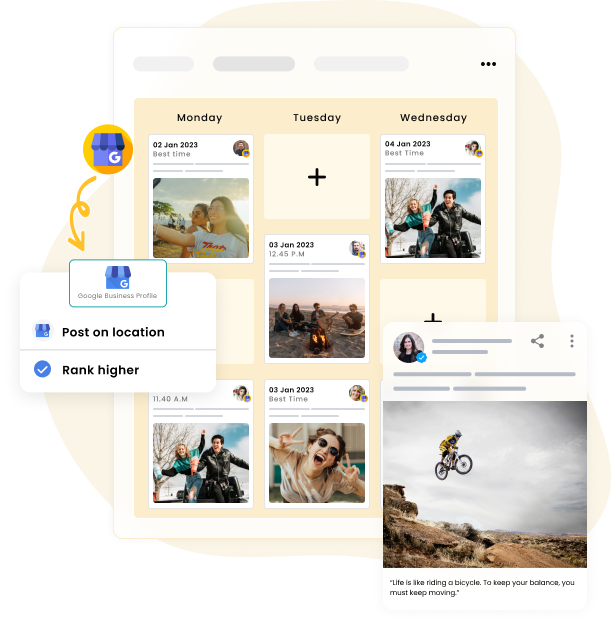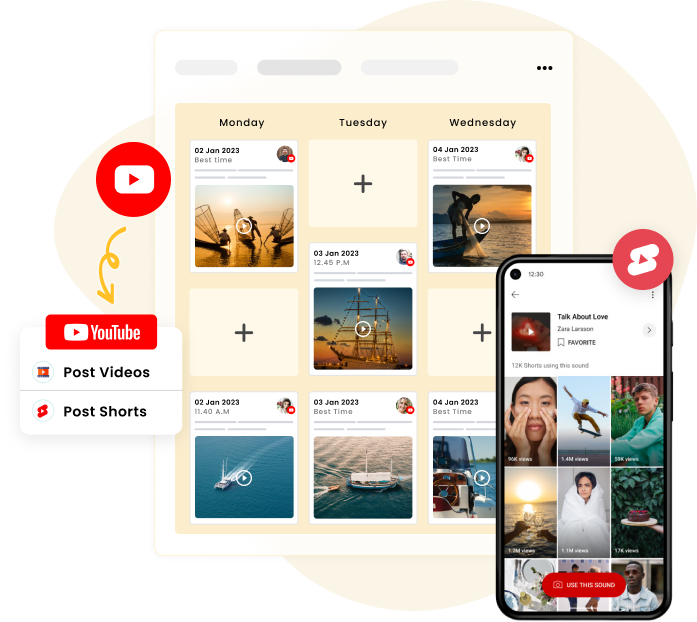Hassle-free Social Media Scheduling
Struggling with scheduling posts for multiple social media accounts? Finding that sweet spot for timing can be tricky, but it's key to boosting your audience's engagement.
Scheduling for Facebook
Managing social media can be cumbersome, with the need to handle multiple Facebook profiles, groups, and pages.
This multitasking is time-consuming and can lead to disorganized content and missed engagement opportunities.
With RecurPost’s advanced content calendar, social media automation tools, asset library, and hashtag targeting, you can plan, engage, and track performance more efficiently.
RecurPost can post first comments on your posts. You can post as a page or one of the many profiles on Facebook groups, and we are one of the rare social media tools that support posting on personal Facebook pages.


Scheduling on Instagram
Struggling to keep your Instagram content fresh and timely across Feeds, Stories, Reels, and Carousels? Our automatic scheduler lets you effortlessly line up your posts, whether they’re images, videos, GIFs, or memes, ensuring you’re always engaging your audience.
Worried about your hashtag game? Our ‘bags of tags’ feature allows you to attach a curated set of hashtags to your posts with just one click, boosting your visibility without the hassle.
And the best part? Using RecurPost feels just like posting directly from Instagram, thanks to our intuitive interface.
Elevate Your Marketing Game with RecurPost: Schedule Smarter, Engage Better!
Scheduling for X (Twitter)
With tweets having lifespan of just 18 minutes, frequency and timing are crucial to capture your audience’s attention. RecurPost ensures your Twitter presence is both consistent and timely.
Prepare and schedule your tweets weekly or monthly with RecurPost to stay ahead of your content strategy. Our automation fills your feed with curated articles, industry news, engaging memes, and more, keeping your followers informed and entertained.
We stay on top of Twitter’s guidelines so that you can ignore the grunt work and just focus on what you love, engaging audiences on Twitter.


RecurPost as a LinkedIn post scheduler
In order to maintain a healthy professional presence and attract the most genuine audience, every business needs to maintain a profile and a company page on LinkedIn.
RecurPost’s social media scheduler lets you take control of both LinkedIn profiles and company pages. You can easily draft, and schedule LinkedIn posts to one or multiple LinkedIn Company Pages or profiles.
After the updates go out on your accounts, you can check their performance and find out the most trending ones.
RecurPost as a Google Business Profile post scheduler
Google Business Profile plays an important role in improving your ranking in Google’s search results.
You can easily increase your search ranking on Google by constantly posting on your listing through our social media automation tool.
Promote new products and services, announce new deals, and share interesting links to create buzz around your business.
Our social media management tool will help you in doing all of these by enabling you to create recurring schedules to go out as posts every week on your profile whenever you schedule Google Business Profile posts.


RecurPost as Pinterest Scheduler
Tired of the endless cycle of pinning manually on Pinterest, trying to make each pin stand out with a unique title, description, and destination link? RecurPost sweeps in to make your life easier.
Dive into our advanced content calendar and discover the joy of automating your Pinterest posts. This isn’t just a time-saver; it’s your ticket to more meaningful interactions with your audience, freeing up your schedule to focus on engagement rather than posting logistics.
Embrace smart scheduling with RecurPost, and watch your Pinterest reach soar. It’s not just about posting; it’s about posting smarter and making every pin count.
RecurPost as a YouTube Scheduler
RecurPost is one of the very few social media schedulers that enables you to schedule YouTube videos as well as shorts.
Our powerful platform allows you to effortlessly schedule your YouTube videos and shorts, so you can focus on what really matters – creating engaging content.
But that’s not all – with RecurPost, you can also add custom thumbnails to your videos, ensuring your brand is always on display. Showcase your unique style and flair with a thumbnail of your choice.
Whether you’re promoting your latest product launch or sharing a new tutorial, RecurPost makes it easy to stand out from the crowd.
What’s more, you can make sure that your videos are posted at the right time by using the AI-based best time scheduling feature.
So, go ahead and connect your YouTube channel now to experience the scheduling magic!

RecurPost supports other networks including but not limited to TikTok and Reddit.
Dive into TikTok with RecurPost’s native support, making your video posting as seamless and impactful as possible. And for Reddit and beyond, our Zapier integration opens the door to effortlessly sync your content across the web, expanding your digital footprint with ease.
Check out RecurPost’s Social media scheduling & Automation tool
Frequently Asked Questions
RecurPost supports you by offering platform-specific insights and features tailored to the unique requirements of each social media platform. With our tool, you can easily adapt your content for different formats, ensuring it meets character limits, image specifications, and hashtag use. This simplifies the process of customizing your content to maximize engagement on each platform.
With RecurPost, you can create and implement a cohesive content strategy that aligns with your marketing goals. Our content calendar and planning tools allow you to schedule your posts in advance, ensuring that your content reflects your brand’s voice and targets the right audience across all platforms. RecurPost’s analytics also help you adjust your strategy based on performance data.
RecurPost’s scheduling tools enable you to plan and automate your posts according to the optimal times for each time zone. This helps you maintain a consistent online presence without the worry of scheduling conflicts or gaps. Our visual content calendar offers a clear overview of your scheduled posts, making it easier to manage your content across multiple accounts and time zones efficiently.
RecurPost inspires creativity by providing content recommendations and allowing for easy repurposing of high-performing posts. Our platform encourages diverse content creation, enabling you to mix formats like videos, images, and text posts to keep your content fresh and engaging. With RecurPost, you can also involve your team in the content creation process through collaborative features, ensuring a steady flow of innovative ideas.
RecurPost’s advanced analytics tools give you a comprehensive view of your content’s performance across all your social media accounts. By setting clear objectives and tracking key metrics, you can easily identify what content resonates with your audience. Our platform enables you to refine your strategy, focus on high-performing content, and demonstrate the ROI of your social media efforts.